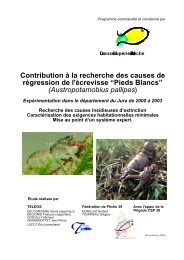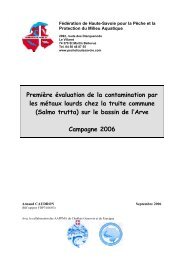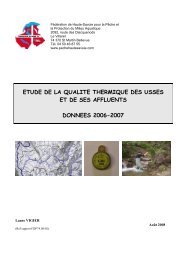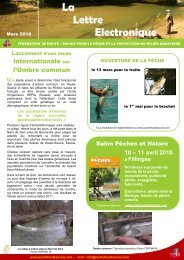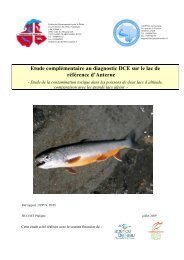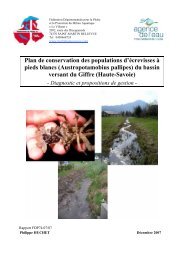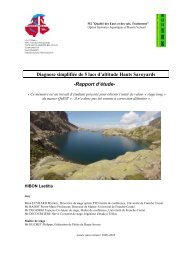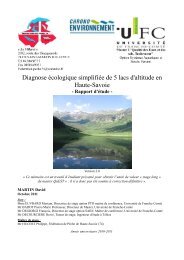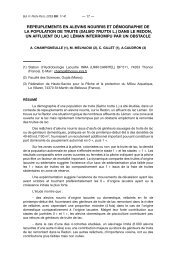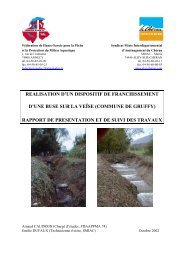Stratégie-de-suppre.. - Fédération de pêche de la Haute-Savoie
Stratégie-de-suppre.. - Fédération de pêche de la Haute-Savoie
Stratégie-de-suppre.. - Fédération de pêche de la Haute-Savoie
- No tags were found...
You also want an ePaper? Increase the reach of your titles
YUMPU automatically turns print PDFs into web optimized ePapers that Google loves.
Eur J Wildl Res (2011) 57:575–583DOI 10.1007/s10344-010-0468-8ORIGINAL PAPERMultiple electrofishing as a mitigate tool for removingnonnative At<strong>la</strong>ntic brown trout (Salmo trutta L.) threateninga native Mediterranean brown trout popu<strong>la</strong>tionArnaud Caudron & Alexis ChampigneulleReceived: 22 February 2010 /Revised: 25 October 2010 /Accepted: 27 October 2010 /Published online: 16 November 2010# Springer-Ver<strong>la</strong>g 2010Abstract In the native range of the brown trout (Salmotrutta L.) in Europe, the hybridization of native popu<strong>la</strong>tionsby nonnative domesticated strains introduced by stocking isone of the most serious threats to the long-term conservationof diversity within this species. With the objective ofconserving and restoring the native gene pool, fisherymanagers are beginning to implement various managementstrategies at the local scale. Nevertheless, few case studieshave been published that investigate the effectiveness of thevarious different conservation strategies for native browntrout popu<strong>la</strong>tions. In the Chevenne Creek, a small Frenchmountain stream, we tested the strategy of removingnonnative individuals by multiple electrofishing carriedout by fishery managers in or<strong>de</strong>r to evaluate its feasibilityand effectiveness for eliminating a nonnative popu<strong>la</strong>tionthreatening a native popu<strong>la</strong>tion. Electrofishing producedmajor reductions in the nonnative popu<strong>la</strong>tion between 2006and 2009, with 82–100% of nonnative individuals beingremoved over a period of 4 years. Nevertheless, <strong>de</strong>spitemultiple-electrofishing campaigns, this nonnative popu<strong>la</strong>tionwas not entirely eradicated, and some natural recruitmentpersisted. The young of the year and subadults wereless effectively removed than the adults. The results suggestthat repeated electrofishing campaigns can be used bymanagers to reduce the nonnative brown trout popu<strong>la</strong>tionwith the objective of conserving the native gene pool, butthe removal operation must be continued for at least 4Communicated by C. GortázarA. Caudron (*): A. ChampigneulleInstitut National Recherche Agronomique (INRA),Centre Alpin <strong>de</strong> Recherche sur les Réseaux Trophiques <strong>de</strong>sEcosystèmes Limniques (CARRTEL),75 avenue <strong>de</strong> Corzent, BP511,74203 Thonon, Francee-mail: acaudron@thonon.inra.frconsecutive years. This strategy, which is feasible in smallstreams, has to be followed by complementary operationsto allow the restoration of a new, native, self-sustainablebrown trout popu<strong>la</strong>tion.Keywords Brown trout . Conservation . Electrofishing .Nonnative trout removalIntroductionThe brown trout (Salmo trutta L.) disp<strong>la</strong>ys a high level ofgenetic diversity in its native range in Europe (Bernatchez2001; Cortey et al. 2004). In France, both Mediterranean(MED) and At<strong>la</strong>ntic (ATL) brown trout popu<strong>la</strong>tions show aclear genetic distinction at mitochondrial and nuclear genes(Guyomard 1989; Bernatchez et al. 1992; Launey et al.2003). In the French north alpine hydrographic catchmentarea, which is part of the Mediterranean basin, MEDpopu<strong>la</strong>tions of brown trout are consi<strong>de</strong>red to be native(Guyomard 1989; Launey et al. 2003). For more than acentury, stocking practices implemented by fishery managershave led to massive introductions of domesticated ATLtrout (Krieg and Guyomard 1985; Launey et al. 2003) intorivers inhabited by native MED popu<strong>la</strong>tions and consequentlyto hybridization and to the <strong>de</strong>cline of native MEDpopu<strong>la</strong>tions in this area (Guyomard 1989; Largiadèr et al.1996).Simi<strong>la</strong>r negative genetic effects of stocking with adomesticated ATL strain on native MED popu<strong>la</strong>tions hasbeen reported in several streams in the Mediterranean basinin France (Barbat-Leterrier et al. 1989; Beaudou et al. 1994;Poteaux et al. 1998; Berrebi et al. 2000), in Spain (Aparicioet al. 2005; Almodóvar et al. 2006), and in Italy (Caputo etal. 2004; Lucentini et al. 2006).
576 Eur J Wildl Res (2011) 57:575–583Throughout the native range of the brown trout inEurope, the hybridization of the native popu<strong>la</strong>tions bydomesticated ATL strains is consi<strong>de</strong>red to be one of themost serious threats to the long-term conservation ofdiversity within this species (Laikre et al. 1999; Ferguson2006).Over the <strong>la</strong>st 10 years, in re<strong>la</strong>tion to the multiplication ofgenetic case studies, fishery administrators have becomeaware of the importance of conserving native popu<strong>la</strong>tions,and fishery managers have begun to take intraspeciesgenetic diversity into account in their management programs.Gradually, alternative management strategies arebeing implemented with the aim of conserving andrestoring the native gene pool at the popu<strong>la</strong>tion level. Thetools that can be used for the conservation and restorationof stream salmonids are (i) genetic refuges (Guyomard1989; Allendorf et al. 1997; Araguas et al. 2009), (ii) theelimination of nonnative fish by chemical methods (Rinneet al. 1981; Harig et al. 2000) or their removal byelectrofishing (Moore et al. 1986; Kulp and Moore 2000;Peterson et al. 2004), (iii) the <strong>de</strong>liberate iso<strong>la</strong>tion ofthreatened native individuals (Novinger and Rahel 2003;Van Houdt et al. 2005), (iv) stocking with local nativebreeding stock (Cowx 1994; Waples 1999; Crivelli et al.2000; Young and Harig 2001; Caudron et al. 2006), (v)translocation of wild individuals (Hil<strong>de</strong>rbrand 2002;Schmetterling 2003; Caudron et al. 2009), and (vi) selectiveangling (Mezzera and Largiadèr 2001).Nevertheless, fishery managers who are also conservationistsare often confronted by problems re<strong>la</strong>ted to thespatial distribution of both native and non-native individuals.For instance, they can be confronted with an allopatricspatial distribution, in which nonnative individuals arelocated downstream and/or upstream of a river stretchinhabited by a native popu<strong>la</strong>tion, or by a sympatricdistribution, in which nonnative and native individuals arefound together in the same stream. It is not easy for wildlifemanagers and fishery managers to select the most appropriateconservation method adapted at each situation.Moreover, fishery managers need to ba<strong>la</strong>nce two differentobjectives, sometimes antagonist, the angling activities andthe conservation of native popu<strong>la</strong>tions.In the northern French Alps area, joint studies involvingboth scientists and fishery managers have ma<strong>de</strong> it possibleto monitor several restoration strategies for native MEDbrown trout popu<strong>la</strong>tions carried out by managers and toevaluate their effectiveness. In the Chevenne Creek, a smallmountain fragmented stream, both ATL nonnative andMED native popu<strong>la</strong>tions show an allopatric spatial repartitionwith an ATL popu<strong>la</strong>tion in the iso<strong>la</strong>ted upper part ofthe river and a MED popu<strong>la</strong>tion located immediatelydownstream (Barnetta 2005). In this situation, where thenative gene pool of the MED popu<strong>la</strong>tion is threatened byATL gene flow from upstream, managers <strong>de</strong>ci<strong>de</strong>d to carryout several restoration strategies. Since 1993, the geneticrefuge banning stocking with ATL trout was establishedand the fishing activity has been prohibited since 1998. In2006, because the ATL popu<strong>la</strong>tion persisted <strong>de</strong>spite 13 yearswithout stocking, managers <strong>de</strong>ci<strong>de</strong>d to carry out thestrategy of removing nonnative individuals by repeate<strong>de</strong>lectrofishing. This choice was motivated by the allopatricdistribution of both ATL and MED popu<strong>la</strong>tions and theiso<strong>la</strong>ted location of the ATL trout in a short upstreamsection which offered an opportunity to evaluate in situ thispractice. The goal of this action, in addition of the geneticrefuge strategy, was to stop the source of alien gene flowfrom upstream, which led the introgression of the nativepopu<strong>la</strong>tion located downstream.The present publication reports data on the still poorlyinvestigated use of electrofishing removal of brown trout.The aims of our study were (i) to monitor a case study ofthis strategy implemented by fishery managers, (ii) toevaluate its feasibility and effectiveness, and (iii) on thebasis of these results obtained for brown trout, togetherwith published results concerning other trout species, todiscuss possible in situ applications of this tool for thebrown trout in its native range in Europe.Study areaThe Chevenne Creek, a typical northern French Alpinemountain stream, is a first-or<strong>de</strong>r tributary of the Dransed’Abondance river, a tributary of the Dranses system,which is the second <strong>la</strong>rgest affluent of Lake Geneva andbelongs to the Mediterranean catchment (Fig. 1). TheChevenne stream is 2.5 km in length and 1–4 m in width;it ranges in altitu<strong>de</strong> from 1,250 to 1,000 m and has a meanslope of 10%.It has the typical geomorphologic characteristics of amiddle-altitu<strong>de</strong> mountain stream in the Alpine zone, with acomplex and fragmented habitat dominated by riffles,casca<strong>de</strong>s, and pools, containing many boul<strong>de</strong>rs and smallwoody <strong>de</strong>bris. The mean conductivity is 360 μS/cm, andthe average pH value is 8.2.Several genetic studies (Bernatchez et al. 1992;Largiadèr and Scholl 1996; Largiadèr et al. 1996; Launeyet al. 2003) have shown that the main stream of the Dransed’Abondance and the downstream and median parts of theChevenne Creek harbor a nearly pure MED popu<strong>la</strong>tions<strong>de</strong>spite intensive stocking with domesticated ATL troutover several <strong>de</strong>ca<strong>de</strong>s (Fig. 1). To preserve the native MEDgene pool, fishery managers set up a genetic refuge wherestocking was stopped since 1993, and angling wasforbid<strong>de</strong>n since 1998.Genetic analysis of samples between 1995 and 2003showed that, after a period of 10 years without stocking
Eur J Wildl Res (2011) 57:575–583 577Fig. 1 Location and characteristicsof the study area. Longitudinalgradient of admixturerate between nonnative At<strong>la</strong>nticand native Mediterranean browntrout along the Chevenne Creek(according to Barnetta 2005).Grey bar: Waterfal<strong>la</strong>nd 5 years without angling pressure, the pattern ofadmixture between ATL and MED trout had not changedsignificantly (from 25 to 20%), and that recent admixtureswere still occurring in the lower section of theupstream part of the Chevenne stream (Barnetta 2005;Largiadèr and Champigneulle unpublished data). Thismixing can be exp<strong>la</strong>ined by the downstream migration ofATL trout from the iso<strong>la</strong>ted upper section of the upstreampart of the Chevenne, which harbors a self-sustained ATLpopu<strong>la</strong>tion, and where natural recruitment occurs. There issome evi<strong>de</strong>nce that this upstream ATL popu<strong>la</strong>tion wasoriginally introduced by stocking: i) the stocking historyindicates that intensive stocking had taken p<strong>la</strong>ce in theupstream part of the Chevenne and ii) a genetic analysisindicated that there was no <strong>de</strong>tectible genetic differencebetween this upstream ATL popu<strong>la</strong>tion, and the hatcherystrain that was used for stocking the Chevenne (Estoup etal. 2000). In this situation, managers <strong>de</strong>ci<strong>de</strong>d to removeATL trout by electrofishing to avoid any possibility ofintrogressive hybridization for the native popu<strong>la</strong>tionlocated downstream.Materials and methodsIn the autumns of 2006, 2007, 2008, and 2009, repeate<strong>de</strong>lectrofishing campaigns were conducted by fisherymanagers in the upper section of the upstream part ofthe Chevenne with the aim of removing any non-nativeATL individuals present. This upper section, which is780 m in length, was divi<strong>de</strong>d in four sectors <strong>de</strong>signatedA3, A2, A1 and A0 from downstream to upstream(Fig. 1).Each year, the electrofishing operations were carried outusing the same battery-powered, portable, backpack electroshocker(Martin Pecheur II, Dream electronique, Saint-Germain-du-Puch, France; power source: cadmium–nickelbattery 12 V, 10 A; currents produced: rectangu<strong>la</strong>r pulsedDC 400 Hz, voltage 300 V, power about 200 W; ano<strong>de</strong>diameter 30 cm).The electrofishing was conducted by a four-person crew;with one person doing the actual electrofishing, and twoothers netting fish followed by the fourth person with abucket. After each electrofishing pass, a fifth personrecor<strong>de</strong>d the length (to the nearest mm) and the weight(±0.1 g) of each trout collected, while the electrofishingcrew continued with their task.Each year, two electrofishing passes were realized ineach section. When the electrofishing passes were finished,all the trout that had been caught were removed from thestudy area.Popu<strong>la</strong>tion <strong>de</strong>nsity (individuals/100 m²) and biomass(kg/ha) estimates and 95% confi<strong>de</strong>nce intervals werecalcu<strong>la</strong>ted for each sector and for the entire stream usingthe maximum likelihood popu<strong>la</strong>tion estimate of Carle andStrub (1978), as recommen<strong>de</strong>d by Ger<strong>de</strong>aux (1987). The
578 Eur J Wildl Res (2011) 57:575–583following condition stipu<strong>la</strong>ted by Seber and Lecren (1967)has been checked prior to these estimations: [C1²*(C1-C2)²]/[C2²*(C1+C2)]>16, where C1 and C2 represent thenumber of trout collected during the first pass and thesecond pass, respectively.The estimates were calcu<strong>la</strong>ted separately for three differentlength c<strong>la</strong>sses that correspon<strong>de</strong>d to young of the year (YOY,40–89 mm), subadults (90–159 mm), and the adult spawners(≥160 mm), respectively. The correspon<strong>de</strong>nces between sizec<strong>la</strong>sses and sexual maturation used in this study had beenvalidated by a previous study in the Chevenne popu<strong>la</strong>tion(Champigneulle et al. 2003).The effectiveness of the removal by electrofishing was<strong>de</strong>termined by the ratio of the number of trout caught, NC(sum of the two passes), divi<strong>de</strong>d by the estimated totalnumber of trout present, NE, given by the Carle and Strub(1978) formu<strong>la</strong>. Confi<strong>de</strong>nce limits of 95% were also givenusing the Carle and Strub (1978) formu<strong>la</strong>. The time taken toperform these removal operations each year was alsodocumented.ResultsRemoval of nonnative brown troutThe popu<strong>la</strong>tion data of 2006 showed that a <strong>la</strong>rge and viablepopu<strong>la</strong>tion of nonnative ATL brown tout was still present inthe upstream section of the Chevenne Creek after 13 yearswithout stocking. This popu<strong>la</strong>tion had a <strong>de</strong>nsity of 33.2(±2.2) individuals/100 m² and a biomass of 148 (±18) kg/ha(Fig. 2).In all, 893 ATL brown trout were removed from the upperpart of the Chevenne by the four removal campaigns. Thisoperation reduced the total <strong>de</strong>nsity by a factor of 4.2, and thetotal biomass by a factor of 8.5, with 7.9 (±0.8) individuals/100 m² and 17.4 (±2.5) kg/ha in 2009 after four removalcampaigns. During the first three removal campaigns, the total<strong>de</strong>nsity fell each year by a factor of about 2, but for the thirdand the fourth years, the <strong>de</strong>nsities were simi<strong>la</strong>r. The totalbiomass <strong>de</strong>creased markedly after the first and fourthremovals, but did not change between the second and thethird years. The spatial <strong>de</strong>crease patterns of both <strong>de</strong>nsity andbiomass were showed some differences between the foursections (Fig. 2).Of the 893 trout removed, 395 (44%) were age 0(
580 Eur J Wildl Res (2011) 57:575–583Fig. 3 Size distribution of nonnative brown trout captured in thestretch studied during 2006–2009. For each year, the <strong>de</strong>nsity (±SD) oftrout is shown for the three size c<strong>la</strong>sses, young of the year (YOY),subadults, and adult spawnerA), although it is more efficient, less time consuming andcheaper than multiple electrofishing (Moore et al. 2005),was not used because the eradication of aquatic organismsusing poison is banned by the French legis<strong>la</strong>tion.Mitigate efficiency of the electrofishing removalto eliminate the introduced brown troutNo comparisons are possible for the brown trout as, as faras we are aware, no simi<strong>la</strong>r removal experiments have beenpublished regarding the problem of two different origins(ATL/MED) of this species. In<strong>de</strong>ed, most studiesconcerning this approach have been conducted in thewestern United States in or<strong>de</strong>r to reduce or eliminate (i)nonnative rainbow trout in the native range of the brooktrout (Moore and Larson 1983; Moore et al. 1986, Larson etal. 1986; Kulp and Moore 2000; Moore et al. 2005) or (ii)nonnative brook trout in the native range of the cutthroattrout, Oncorhynchus c<strong>la</strong>rkii (Thompson and Rahel 1996;Shepard et al. 2002; Peterson et al. 2004).In the Chevenne stream, electrofishing removal ma<strong>de</strong> itpossible to reduce both the biomass and the <strong>de</strong>nsity of theATL nonnative popu<strong>la</strong>tion consi<strong>de</strong>rably between 2006 and2009. On average 82–100% of nonnative ATL individualswere removed over a 4-year period. Nevertheless, <strong>de</strong>spite themultiple-electrofishing campaigns, this nonnative popu<strong>la</strong>tionwas not wholly eradicated and some natural recruitmentpersisted.Our findings for brown trout species are simi<strong>la</strong>r to theresults obtained in small streams for other nonnative troutspecies (rainbow trout and brook trout). Thompson andRahel (1996) indicated a success rate of 59–100% for age 1and ol<strong>de</strong>r brook trout for single, three-pass electrofishingremoval efforts. Shepard et al. (2002) found that 8 yearswere necessary for the total removal of brook trout. Theeffective removal of nonnative trout also required intensiveelectrofishing over some years (Moore and Larson 1983;Moore et al. 1986; Kulp and Moore 2000). All the studiespublished have reported lower removal efficiencies for age-0 than for ol<strong>de</strong>r trout. In the present study, the efficienciesof YOY removal ranged from 71–91% to 91–100% (basedon <strong>de</strong>pletion estimates), and were lower than those foradults (≥160 mm). Furthermore, the removal efficiencieswere lower in 2006 and 2008, when the YOY were smaller,than in 2007 and 2009. Size selectivity is a well-knownphenomenon in electrofishing surveys in several species offish (Junge and Libosvarsky 1965; Reynolds 1989; Do<strong>la</strong>nand Miranda 2003), and it must be allowed if we are toincrease the success of restoration by means of electrofishingremoval. In the present experiment, we did not find anydifference for the removal efficiencies in YOY (
Eur J Wildl Res (2011) 57:575–583 581control of brook trout by electrofishing can help maintainnative cutthroat trout popu<strong>la</strong>tions, but to be effective,multiple consecutive years of <strong>suppre</strong>ssion over at least3 years without interruption were necessary.In the present study, single two-pass electrofishingremoval campaigns per year for 4 consecutive years di<strong>de</strong>ffectively reduce the number of nonnative ATL brown troutbut were not sufficient to eliminate them completely. In<strong>de</strong>ed,in the Chevenne, the <strong>la</strong>test popu<strong>la</strong>tion estimates indicate that33 non-spawner trout (40 mm) to be immobilized by electrofishing gearso that their catchability is greater and when spawners havenot yet spawned.Finally, the electrofishing removal method can be usedboth when nonnative and native individuals are distributed inan allopatric manner, but it can also be used in a sympatricsituation when it is easy to distinguish visually between fish ofthe different origins. For instance, this is the case for severalnative lineages of brown trout in Europe which disp<strong>la</strong>y
582 Eur J Wildl Res (2011) 57:575–583morphologic and phenotype differences such as thosebetween the ATL and MED lineages (Mezzera et al. 1997;Aparicio et al. 2005), between the Danubian and Marmoratuslineages and those between the ATL and Marmoratuslineages (Delling et al. 2000). This removal method can alsobe used in a context of the invasion of native brown troutpopu<strong>la</strong>tions by introduced brook trout, as has recently beenreported (Cucherousset et al. 2008; Korsu et al. 2009).Acknowledgement We would like to thank the technical team of the<strong>Haute</strong>-<strong>Savoie</strong> Departmental Fe<strong>de</strong>ration of Fisheries: G. Bini, L. Catinaud,P. Huchet, and L. Vigier for their participation in the field operations.ReferencesAllendorf FW, Bayles D, Bottom DL, Currens KP, Frissell CA,Hankin D, Lichatowich JA, Nehlsen W, Trotter PC, Williams TH(1997) Prioritizing pacific salmon stocks for conservation.Conserv Biol 11:140–152Almodóvar A, Nico<strong>la</strong> GG, Elvira B, García-Marín JL (2006)Introgression variability among Iberian brown trout evolutionarysignificant units: the influence of local management an<strong>de</strong>nvironmental features. Freshw Biol 51:1175–1187Aparicio E, García-Berthou E, Araguas RM, Martínez P, Garcia MarinJL (2005) Body pigmentation pattern to assess introgression byhatchery stocks in native Salmo trutta from Mediterraneanstreams. J Fish Biol 67:931–949Araguas RM, Sanz N, Fernan<strong>de</strong>z R, Utter FM, P<strong>la</strong> C, Garcia Marin JL(2008) Genetic refuges for a self-sustained fishery: experience inwild brown trout popu<strong>la</strong>tions in the eastern Pyrenees. EcolFreshw Fish 17:610–616Araguas RM, Sanz N, Fernan<strong>de</strong>z R, Utter FM, P<strong>la</strong> C, Garcia Marin JL(2009) Role of genetic refuges in the restoration of native genepools of Brown trout. Conserv Biol 23:871–878Barbat-Leterrier A, Guyomard R, Krieg F (1989) Introgressionbetween introduced domesticated strains and Mediterraneannative popu<strong>la</strong>tions of brown trout (Salmo trutta L.). AquatLiving Resour 2:215–223Barnetta S (2005) Temporal admixture analysis of At<strong>la</strong>ntic andMediterranean brown trout in the Chevenne. Diplomarbeit <strong>de</strong>rphilosophisch-naturwissenschaftlichen, University of BernBeaudou D, Cattaneo-Berrebi G, Berrebi P (1994) Impacts génétiques<strong>de</strong>s repeuplements en truites communes (Salmo trutta L.) sur lespopu<strong>la</strong>tions en p<strong>la</strong>ce: cas du bassin <strong>de</strong> l’Orb (Hérault). Bull FrPêche Piscic 332:83–92Berrebi P, Poteaux C, Fissier M, Cattaneo-Berrebi G (2000) Stockingimpact and allozyme diversity in brown trout from Mediterraneansouthern France. J Fish Biol 56:949–960Bernatchez L (2001) The evolutionary history of brown trout Salmotrutta L. inferred from phylogeographic, nested c<strong>la</strong><strong>de</strong> andmismatch analyses of mitochondrial DNA variation. Evol55:351–379Bernatchez L, Guyomard R, Bonhomme F (1992) DNA sequencevariation of the mitochondrial control region among geographicallyand morphologically remote European brown trout Salmotrutta popu<strong>la</strong>tions. Mol Ecol 1:161–173Caputo V, Giovannotti M, Nisi Cerioni P, Caniglia ML, Splendiani A(2004) Genetic diversity of brown trout in central Italy. J FishBiol 65:403–418Carle FL, Strub MR (1978) A new method for estimating popu<strong>la</strong>tionsize from removal data. Biometrics 34:624–630Caudron A, Champigneulle A (2006) Etats et caractéristique <strong>de</strong>spopu<strong>la</strong>tions autochtone <strong>de</strong> truite commune i<strong>de</strong>ntifiées en <strong>Haute</strong>-<strong>Savoie</strong> et qualité globale <strong>de</strong>s milieux. Rapport INTERREG III A. http://www.truites-autochtones.org/uploads/re<strong>la</strong>zione_fin/011_III_Etats%20et%20caract%C3%A9ristiques%20<strong>de</strong>s%20popu<strong>la</strong>tions.pdf.Accessed 25 June 2010Caudron A, Champigneulle A, Guyomard R (2006) Assessment ofrestocking as a strategy for rehabiliting a native popu<strong>la</strong>tion ofbrown trout (Salmo trutta L.) in a fast-flowing mountain streamin the northern French Alps. J Fish Biol 69:127–139Caudron A, Champigneulle A, Guyomard R (2009) Evi<strong>de</strong>nce of twocontrasting brown trout Salmo trutta popu<strong>la</strong>tions spatially separatedin the River Borne (France) and shift in management towardsconservation of the native lineage. J Fish Biol 74:1070–1085Caudron A, Champigneulle A, Guyomard R, Largiadèr CR (2010)Assessment of three strategies practiced by fishery managers forrestoring native brown trout (Salmo trutta) popu<strong>la</strong>tions inNorthen French Alpine streams. Ecol Freshw Fish (in press)Champigneulle A, Cachera S (2003) Evaluation of <strong>la</strong>rge scalestocking of early stages of brown trout, Salmo trutta, to anglercatches in the French–Swiss part of the River Doubs. FishManage Ecol 10:79–85Champigneulle A, Largia<strong>de</strong>r CR, Caudron A (2003) Reproduction <strong>de</strong><strong>la</strong> truite (Salmo trutta) dans le torrent <strong>de</strong> Chevenne, <strong>Haute</strong>-<strong>Savoie</strong>. Un fonctionnement original? Bull Fr Pêche Piscic369:41–70Cortey M, P<strong>la</strong> C, García-Marín JL (2004) Historical biogeography ofMediterranean trout. Mol Phylogenet Evol 33:831–844Cowx IG (1994) Stocking strategies. Fish Manage Ecol 1:15–30Crivelli A, Poizat G, Berrebi P, Jesensek D, Rubin JF (2000)Conservation biology applied to fish: the example of a projectfor rehabiliting the marble trout (Salmo marmoratus) in Slovenia.Cybium 24(3):211–230Cucherousset J, Aymes JC, Poulet N, Santoul F, Céréghino R (2008)Do native brown trout and nonnative brook trout interactreproductively? Naturwissenschaften 95:647–654Delling B, Crivelli AJ, Rubin JF, Berrebi P (2000) Morphologicalvariation in hybrids between Salmo marmoratus and alien Salmospecies in the Vo<strong>la</strong>rja stream, Soca River basin, Slovenia. J FishBiol 57:1199–1212Do<strong>la</strong>n CR, Miranda LE (2003) Immobilization thresholds of electrofishingre<strong>la</strong>tive to fish size. Trans Am Fish Soc 132:969–976Dwyer WP (1990) Catchability of three strains of cuttroat trout. N AmJ Fish Manage 10:458–461Estoup A, Largia<strong>de</strong>r CR, Cornuet JM, Gharbi K, Presa P, Guyomard R(2000) Juxtaposed microsatellites systems as diagnostic markersfor admixture, an empirical evaluation with brown trout (Salmotrutta) as mo<strong>de</strong>l organism. Mol Ecol 9:1873–1886Ferguson A (2006) Genetic impacts of stocking on indigenous browntrout popu<strong>la</strong>tions. Science report: SC040071/SR, http://www.environment-agency.gov.uk/static/documents/Business/sc04007_120407__1804106.pdf. Accessed 06 January 2010Fisher J, Lin<strong>de</strong>nmayer DB (2000) An assessment of the publishedresults of animal relocations. Biol Conserv 96:1–11Garcia-Marin JL, Sanz N, P<strong>la</strong> C (1998) Proportions of native andintroduced brown trout in adjacent fished and unfished Spanishrivers. Conserv Biol 12:313–319Ger<strong>de</strong>aux D (1987) Revue <strong>de</strong>s métho<strong>de</strong>s d’estimation <strong>de</strong> l’efficacitéd’une popu<strong>la</strong>tion par pêches successives avec retrait, programmed’estimation d’effectif par <strong>la</strong> métho<strong>de</strong> Carle et Strub. Bull FrPêche Piscic 304:13–21Guyomard R (1989) Diversité génétique <strong>de</strong> <strong>la</strong> truite commune. Bull FrPêche Piscic 314:118–135Harig AL, Fausch KD, Young MK (2000) Factors influencing successof greenback cutthroat trout translocations. N Am J Fish Manage20:994–1004
Eur J Wildl Res (2011) 57:575–583 583Hil<strong>de</strong>rbrand RH (2002) Simu<strong>la</strong>ting supplementation strategies forrestoring and maintaining stream resi<strong>de</strong>nt cutthroat trout popu<strong>la</strong>tions.N Am J Fish Manage 22:879–887Junge CO, Libosvarsky J (1965) Effect of size selectivity onpopu<strong>la</strong>tion estimates on successive removals with electrofishinggear. Zool Listy 14:171–178Korsu K, Huusko A, Muotka T (2009) Invasion of north Europeanstreams by brook trout: hostile takeover or pre-adapted habitat nichesegregation? Biol Invasions. doi:10.1007/s10530-009-9553-xKrieg F, Guyomard R (1985) Popu<strong>la</strong>tion genetics of French browntrout (Salmo trutta L.): <strong>la</strong>rge geographical differentiation of wildpopu<strong>la</strong>tions and high simi<strong>la</strong>rity of domesticated stocks. Gen SelEvol 17:225–242Kulp MA, Moore SE (2000) Multiple electrofishing removals foreliminating rainbow trout in a small southern Appa<strong>la</strong>chianstream. N Am J Fish Manage 20:259–266Laikre L et al (1999) Conservation genetic management of Browntrout (Salmo trutta) in Europe. Troutconcert EU FAIR CT97-3882). http//www.dfu.min.dk/ffi/consreport/in<strong>de</strong>x.htm. Accessed25 June 2005Largiadèr CR, Scholl A (1996) Genetic introgression between nativeand introduced brown trout (Salmo trutta) popu<strong>la</strong>tions in theRhône River Basin. Mol Ecol 5:417–426Largiadèr CR, Scholl A, Guyomard R (1996) The role of natural andartificial propagation on the genetic diversity of brown trout(Salmo trutta L.) of the upper Rhône drainage. In: Krchhofer A,Hefti D (eds) Conservation of endangered freshwater fish inEurope. Birkhaüser Ver<strong>la</strong>g Basel, Switzer<strong>la</strong>nd, pp 181–197Larson GL, Moore SE, Lee DC (1986) Angling and electrofishing forremoving non-native rainbow trout from a stream in a nationalpark. N Am J Fish Manage 6:580–585Launey S, Krieg F, Champigneulle A, Guyomard R (2003) Ecotypessympatriques migrateurs et sé<strong>de</strong>ntaires <strong>de</strong> truite commune (Salmotrutta L.): différenciation génétique et effet <strong>de</strong>s repeuplements.Les Actes du BRG 4:63–78Lucentini L, Palomba A, Gigliarelli L, Lancioni H, Viali P, Panara F(2006) Genetic characterization of a putative indigenous browntrout (Salmo trutta fario) popu<strong>la</strong>tion in a secondary stream of theNera River basin (Central Italy) assessed by means of threemolecu<strong>la</strong>r markers. Ital J Zool 73:263–273Meyer KA, Lamansky JA, Schill DJ (2006) Evaluation of anunsuccessful brook trout electrofishing removal project in asmall rocky mountain stream. N Am J Fish Manage 26:849–860Mezzera M, Largiadèr CR (2001) Evi<strong>de</strong>nce for selective angling ofintroduced trout and their hybrids in a stocked brown troutpopu<strong>la</strong>tion. J Fish Biol 59:287–301Mezzera M, Largiadèr CR, Scholl A (1997) Discrimination of nativeand introduced brown trout in the River Doubs (Rhône drainage)by number and shape of parr marks. J Fish Biol 50:672–677Minckley WL (1995) Translocation as a tool for conserving imperiledfishes: experiences in western United States. Biol Conserv72:297–309Moore SE, Larson GL (1983) Standing crops of brook trout concurrentwith removal of rainbow trout from selected stream in GreatSmocky Mountains National Park. N Am J Fish Manage 3:72–80Moore S, Larson GL, Ridley BL (1986) Popu<strong>la</strong>tion control of exoticrainbow trout in streams of a national area park. Environ Manage10:215–219Moore SE, Kulp MA, Hammonds J, Rosenlund B (2005) Restoration ofSams Creek and an assessment of brook trout restoration methods inGreat Smoky Mountains National Park. Technical report NPS/NRWRD/NRTR-2005/342. http://www.flyfishingforbrooktrout.com/grsm_sams_creek_restoration_view%20Smokey%20mts.pdf.Accessed 17 December 2009Novinger DC, Rahel FJ (2003) Iso<strong>la</strong>tion management with artificialbarriers as a conservation strategy for cutthroat trout in headwaterstreams. Conserv Biol 17:772–781Paul AJ, Post JR, Stelfox JD (2003) Can anglers influence theabundance on native and non-native Salmonids in a stream fromCanadian Rocky Mountains? N Am J Fish Manage 23:109–119Peterson DP, Fausch KD, White GC (2004) Popu<strong>la</strong>tion of an invasion:effects of brook trout on native cutthroat trout. Ecol Appl 14(3):754–772Peterson DP, Fausch KD, Watmough J, Cunjak RA (2008) Wheneradication is not an option: mo<strong>de</strong>lling strategies for electrofishing<strong>suppre</strong>ssion of nonnative brook trout to foster persistence ofsympatric native cutthroat trout in small streams. N Am J FishManage 28:1847–1867Poteaux C, Beaudou D, Berrebi P (1998) Temporal variations ofgenetic introgression in stocked brown trout popu<strong>la</strong>tions. J FishBiol 53:701–713Reynolds JB (1989) Electrofishing. In: Nielsen LA, Johnson D (eds)Fisheries techniques. American Fisheries Society, Bethesda, pp147–163Riley SC, Fausch KD (1992) Un<strong>de</strong>restimation of trout popu<strong>la</strong>tion sizeby maximum-likelihood removal estimates in small streams. NAm J Fish Manage 12:768–776Rinne JN, Minckley WL, Hanson JN (1981) Chemical treatment ofOrd Creek, Apache country, Arizona, to re-establish Arizonatrout. J Ariz Nev Acad Sci 16:74–78Schmetterling DA (2003) Reconnecting a fragmented river: movementsof westlope cutthroat trout and bull trout after transport upstream ofMilltown Dam, Montana. N Am J Fish Manage 23:721–731Seber GAF, Lecren ED (1967) Estimating popu<strong>la</strong>tion parameters fromcatches <strong>la</strong>rge re<strong>la</strong>tive to the popu<strong>la</strong>tion. J Anim Ecol 36:631–643Shepard BB, Spoon R, Nelson L (2002) A native westlope cutthroattrout popu<strong>la</strong>tion responds positively after brook trout remova<strong>la</strong>nd habitat restoration. Intermount J Sci 8(3):193–214Stelfox JD, Baayens DM, Eisler GR, Paul AJ, Shumaker GE (2004)Quirk Creek brook trout <strong>suppre</strong>ssion project. Wild trout VIIISymposium, 265–275. http://c<strong>la</strong>sses.uleth.ca/200901/biol4500a/Readings/Stelfox2.pdf. Accessed 17 December 2009Stockwell CA, Mulvey M, Vinyard GL (1996) Translocation andpreservation of allelic diversity. Conserv Biol 10:1133–1141Thompson PD, Rahel FJ (1996) Evaluation of <strong>de</strong>pletion-removalelectrofishing of brook trout in small rocky mountain streams. NAm J Fish Manage 16:332–339Van Houdt JKJ, Pinceel J, F<strong>la</strong>mand MC, Briquet M, Dupont E,Volckaert FAM, Baret PV (2005) Migration barriers protectindigenous brown trout (Salmo trutta) popu<strong>la</strong>tions fromintrogression with stocked hatchery fish. Conserv Gen 6:175–191Waples RS (1999) Dispelling some myths about hatcheries. Fish24:12–21Young MK, Harig AL (2001) A critique of the recovery of greenbackCutthroat trout. Conserv Biol 15(6):1575–1584



